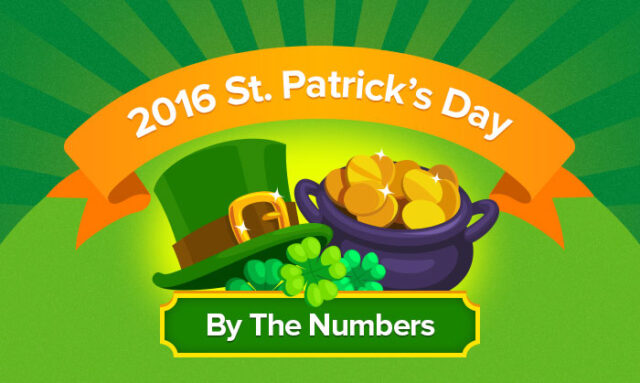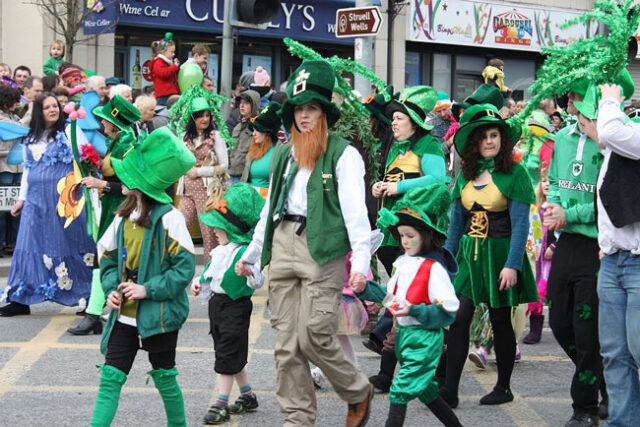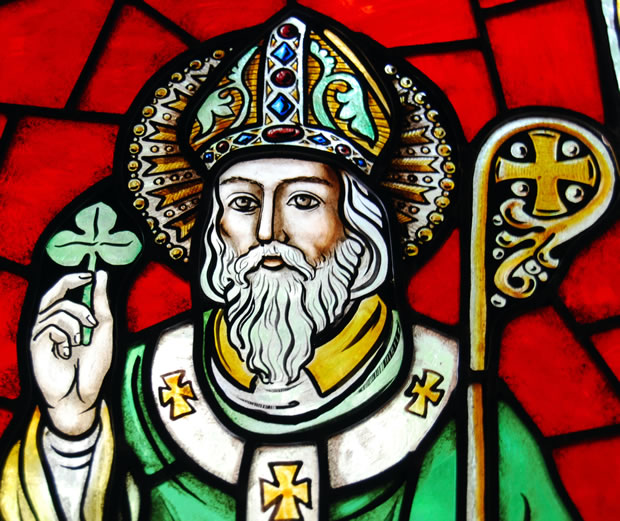
Today around the world is celebrated St. Patrick’s Day. It is a day that have a interesting story full of legends and myths, something that enriches our knowledge of European, Irish and general culture. On Saint Patrick’s Day, millions of people wear green, celebrate everything Irish on parades, with toast and maybe with a large mug of beer. To find out how, where and to which extent is celebrated, take a look at the interesting statistics for 2016 in infographic below:

Today is St. Patrick’s Day, known primarily for large quantities of beer which many today drink, “celebrating” this day. But, as often happens with various prominent days, many have already forgotten what it actually does and why there is a St. Patrick’s Day.
To begin with, who is Patrick? It is the Irish saint (385-461), but on this day, March 17, every year, is the day of his death. St. Patrick’s Day began to be commemorated as the Christian feast day in the early 17th century. This day is marked by many Christians, including Christians, Orthodox, Lutherans and Anglican community.
The day on which the Irish people remember St. Patrick’s Day is also a day on which they celebrate the arrival of Christianity in Ireland, but is now celebrated throughout the world as a celebration of Irish culture in general.
The celebration of Ireland and pause for beer
Celebrations generally include parades and festivals. Many Christians today go to church, but it is interesting that this day is taken as a short break from Lent, and the ban on the consumption of alcoholic beverages – here comes the tradition of enjoying the abundant alcohol during this day.
St. Patrick’s Day is a national holiday in Ireland, and course great Irish diaspora around the world. They are joined by many others who are far more accustomed to it that St. Patrick’s Day a day of fun and relaxation, celebrating Ireland and all Irish. It is interesting to mention that St. Patrick’s Day is celebrated in more countries than any other national festival.

Saint Patrick and his struggle against the Druids
But who exactly was that Patrick and why is he so celebrated? It is, as we have previously mentioned, the Christian missionary and bishop in Ireland. Most things that are known about him is known from the so-called Declaration that, according to beliefs, he wrote. It is believed that he was born into a wealthy family in the area of Roman Britain in the 4th century.
When he was 16, he was kidnapped by Irish brigands and took him back to Ireland. It is said that next six years Patrick spent working as a shepherd and then “acknowledge God”. The Declaration says that God told him to flee to the coast where he will wait for the ship that would take him home. On his return to Britain, Patrick became a priest.
According to tradition, Patrick later returned to Ireland to the Irish pagans and converted them to Christianity. The declaration says that he spent many years in the northern part of Ireland where he converted ” the thousands of pagans.” Of course, he had to face the Irish druids (priests and sages in communities of ancient Celts) and emerged victorious. According to the legend, there is no snakes in Ireland because Patrick banished the,. It is an interesting fact that in Ireland, except in zoos, indeed there is no snakes.
Tradition tells us that he died on March 17, and that he was buried in Downpatrick which is 30 km south of Belfast. From then until today have gone through many centuries and there are many legends have been told about Saint Patrick who ultimately became the most famous and the main Irish saint.
Green shamrock
About Patrick’s fight against Celtic druids probably many don’t know much, but other than beer certainly another symbol of this day is – green shamrock. Moreover, on this day everybody wear green.
Why? This story is also embroidered with St. Patrick. The tradition says that he often used to wear tucked shamrock with three leaves to picturesque clarify to “filthy” Irish pagans the meaning of the Holy Trinity (Holy Trinity in Christianity is name of God when he wants to emphasize the lesson that he is one, and at the same time consists of three persons: Father, Son and Holy Spirit).
The green color is associated with Ireland since the mid-17th century when it was used on the flag of the Irish Catholic Confederation. Since then, the green and shamrock are the main symbols of the celebration of St. Patrick’s Day today.

Irish leprechaun
One of the symbols of Ireland, or the celebration of St. Patrick, is certainly dwarf Irish leprechaun dressed in green. He, unlike the other above-mentioned symbolism, has nothing to do with St. Patrick, and was part of the old Irish legend.
According to some legends, he brings happiness – it is said that leprechaun collect the treasure, and the man who succeed to catch him, perhaps get this treasure. Irish leprechaun, unlike traditional leprechauns, drinks, swears, has increased sex drive and the only thing that binds him with the classic leprechauns is immortality. And in appearance has a great difference. Irish leprechaun is actually the same as a man, but much smaller, like dwarf.
St. Patrick’s Day today
Unfortunately, like many other days and this one is extremely commercialized. However, with this text, you’ve probably learned more about St. Patrick’s Day, so now you can tonight while sipping a beer tell your friends an occasional anecdote about why the Ireland has no snakes or why the shamrock has become a symbol of Ireland. Have a good time!













